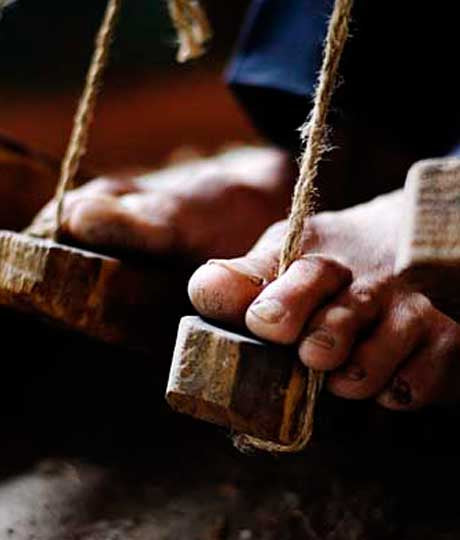On Orders Over $200*
Making Of A Pashmina Shawl

CASHMERE is the name derived from the old spelling of Kashmir ‘Cashmeer’ and Pashmina means “gold wool” in Persian, the name given to the wool fabric produced in Kashmir.
The weaving process is an art originating from the 15C and hasn’t changed much since.
The weaving of a Kashmir Pashmina Shawl is done using the centuries old processes and techniques. Pashmina shawl is weaved by an artisan called Wovur in Kashmir and the process is called Wonun.


The weaver works like a pianist working simultaneously with his feet and hands.
It takes about three to four days to weave a single Pashmina stole or shawl.
The warp is made by manually winding the pashmina yarn across 4 to 8 iron rods erected on the ground. This process is called Yarun in Kashmiri.
Approximately 1200 threads are stretched across 10 mts to complete a warp. The person making the warp has to walk 1200 X 10 mts or 12 kms around the iron rods.


Dressing the Warp: Before the warp can be put on the handloom it has to be dressed by a person called Bharangur or Warp-Dresser. The process called Bharun in Kashmir involves stretching and fixing of yarn in the heddles of a loom called saaz in Kashmiri.
Winding of Yarn: The stratchy yarn after drying in sun is again wound on wooden spindles called prech in Kashmiri. This process is called Tulun in Kashmiri.


Dyeing: Depending on the requirement the yarn is dyed by specialist dyers called Ranger.
However, the process of making a Kashmir Pashmina Shawl starts much before with herding and rearing of Pashmina Goats at an altitude of 4500mts above sea level.
To survive the cold temperatures next only to Siberia, at these altitudes the goats develop a fine fleece under the thick outside fur.


This wool is collected by “Herders” during the spring season and it grows back till the time winter is sets in.
Washing in Spring Water
The final washing is of the shawl is done in spring water with mild detergents and striking the fabric repeatedly against a smooth stone by a specialist washer.


Making of Fringes
Another master craftsman called Voste approves or asks for the changes in the design. Once approved the shawl is passed on to the artisan for embroidery who completes the embroidery based on the approved colors.
